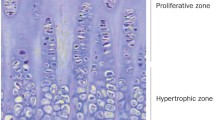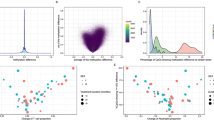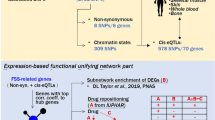Abstract
Idiopathic Short Stature (ISS) defines a condition in which height is <−2SD compared to the mean of a reference population where systemic, endocrinological, nutritional or chromosomal disorders have not been identified and diagnosis is based on exclusion of any known causes of short stature. JAK/STAT pathway is triggered by GH binding to the GH receptor and promotes cellular growth through transcription of GH-responsive genes. In order to identify “candidate genes” differently expressed in ISS subjects with respect to control ones, we analyzed the expression of 84 genes related to JAK/STAT pathway by RT2 Profiler PCR array approach in a total of 10 subjects. Then, we validated the observed data by Real Time PCR and ELISA assays in a major number of subjects. We found two genes that were differently expressed in ISS subjects with respect to the control group: CXCL9 and FCGR1A/CD64, both significantly up-regulated (fold change 2.17 and 1.70, respectively) and belonging to family of IFN-γ-inducible factors. Further, ISS subjects showed an increased gene expression of IFN-γ and IFI16, higher serum levels of IFN-γ but similar levels of CXCL9 when compared to healthy subjects. In addition, we showed a pubertal modulation of CXCL9 levels. These data suggest that inflammatory and regulatory factors of the cell cycle may be involved in the ISS condition, introducing a new perspective to its etiology.


Similar content being viewed by others
References
Cohen P, Rogol AD, Deal CL, Saenger P, Reiter EO, Ross JL, Chernausek SD, Savage MO, Wit JM (2008) ISS Consensus Workshop participants: consensus statement on the diagnosis and treatment of children with idiopathic short stature: a summary of the Growth Hormone Research Society, the Lawson Wilkins Pediatric Endocrine Society, and the European Society for Paediatric Endocrinology Workshop. J Clin Endocrinol Metab 93(11):4210–4217
Rosenfeld RG, Kofoed E, Little B, Woods K, Buckway C, Pratt K, Hwa V (2004) Growth hormone insensitivity resulting from post-GH receptor defects. Growth Horm IGF Res 14:S35–S38
Rojas-Gil AP, Ziros PG, Diaz L, Kletsas D, Basdra EK, Alexandrides TK, Zadik Z, Frank SJ, Papathanassopoulou V, Beratis NG, Papavassiliou AG, Spiliotis BE (2006) Growth hormone/JAK-STAT axis signal-transduction defect. A novel treatable cause of growth failure. FEBS J 273(15):3454–3466
Ferreira LV, Silvia CA, Souza L, Malaquias AC, Arnhold IJ, Mendonca BB, Jorge AA (2008) Analysis of the PTPN11 gene in idiopathic short stature children and Noonan syndrome patients. Clin Endocrinol 69:426–431
Shanske AL, Puri M, Marshall B, Saenger P (2007) Unique deletion in exon 5 of SHOX gene in a patient with idiopathic short stature. Horm Res 67(2):61–66
De Bellis A, Colao A, Tirelli G, Ruocco G, Di Somma C, Battaglia M, Pane E, Bellastella G, Dello Iacovo A, Sinisi AA, Bizzarro A, Bellastella A (2008) Autoimmunity as a possible cause of growth hormone deficiency. J Endocrinol Invest 31(12):1132–1134
Levy DE, Darnell JE Jr (2002) Stats: transcriptional control and biological impact. Natl Rev Mol Cell Biol 3:651–666
Rawlings JS, Rosler KM, Harrison DA (2004) The JAK/STAT signaling pathway. J Cell Sci 117:1281–1283
Krempler A, Qi Y, Triplett AA, Zhu J, Rui H, Wagner KU (2004) Generation of a conditional knockout allele for the Janus kinase 2 (Jak2) gene in mice. Genesis 40(1):52–57
Woelfle J, Chia DJ, Rotwein P (2003) Mechanisms of growth hormone (GH) action. Identification of conserved Stat5 binding sites that mediate GH induced insulin-like growth factor-I gene activation. J Biol Chem 278:51261–51266
Ambrosio R, Fimiani G, Monfregola J, Sanzari E, De Felice N, Salerno MC, Pignata C, D’Urso M, Ursini MV (2002) The structure of human STAT5A and B genes reveals two regions of nearly identical sequence and an alternative tissue specific STAT5B promoter. Gene 285(1–2):311–318
Weedon MN, Frayling TM (2008) Reaching new heights: insights into the genetics of human stature. Trends Genet 24(12):595–603
Cacciari E, Milani S, Balsamo A, Spada E, Bona G, Cavallo L, Cerutti F, Gargantini L, Greggio N, Tonini G, Cicognani A (2006) Italian cross-sectional growth charts for height, weight and BMI (2 to 20 yr). J Endocrinol Invest 29(7):581–593
SMILA Neonatal Standards for North-East Italy, Montecatini, September 1996, pp 26–31
Arikawa E, Sun Y, Wang J, Zhou Q, Ning B, Dial SL, Guo L, Yang L (2008) Cross-platform comparison of SYBR Green real-time PCR with TaqMan PCR, microarrays and other gene expression measurement technologies evaluated in the MicroArray Quality Control (MAQC) study. BMC Genomics 9:328
Trovato L, Riccomagno S, Prodam F, Genoni G, Walker GE, Moia S, Bellone S, Bona G (2011) Isolated GHD: investigation and implication of JAK/STAT related genes before and after rhGH treatment. Pituitary. doi:10.1007/s11102-011-0354-8
Hujeirat Y, Hess O, Shalev S, Tenenbaum-Rakover Y (2006) Growth hormone receptor sequence changes do not play a role in determining height in children with idiopathic short stature. Horm Res 65(4):210–216
Rosenfeld RG, Belgorosky A, Camacho-Hubner C, Savage MO, Wit JM, Hwa V (2007) Defects in growth hormone receptor signaling. Trends Endocrinol Metab 18:134–141
Kralovics R, Passamonti F, Buser AS, Teo SS, Tiedt R, Passweg JR, Tichelli A, Cazzola M, Skoda RC (2005) A gain-of-function mutation of JAK2 in myeloproliferative disorders. N Eng J Med 352:1779–1790
O’Connor JC, McCusker RH, Strle K, Johnson RW, Dantzer R, Kelley KW (2008) Regulation of IGF-I function by proinflammatory cytokines: at the interface of immunology and endocrinology. Cell Immunol 252(1–2):91–110
Rotondi M, Chiovato L, Romagnani S, Serio M, Romagnani P (2007) Role of chemokines in endocrine autoimmune diseases. Endocr Rev 28(5):492–520
Wong SC, MacRae VE, Gracie JA, McInnes IB, Galea P, Gardner-Medwin J, Ahmed SF (2008) Inflammatory cytokines in juvenile idiopathic arthritis: effects on physical growth and insulin-like-growth factor axis. Growth Horm IGF Res 18(5):369–378
Tillinger W, Jilch R, Jilma B, Brunner H, Koeller U, Lichtenberger C, Waldhör T, Reinisch W (2009) Expression of the high-affinity IgG receptor FcRI (CD64) in patients with inflammatory bowel disease: a new biomarker for gastroenterologic diagnostics. Am J Gastroenterol 104:102–109
Standage SW, Wong HR (2011) Biomarkers for pediatric sepsis and septic shock. Expert Rev Anti Infect Ther 9(1):71–79
Borden EC, Lindner D, Dreicer R, Hussein M, Peereboom D (2000) Second-generation interferons for cancer: clinical targets. Semin Cancer Biol 10:125–144
Liao JC, Lam R, Brazda V, Duan S, Ravichandran M, Ma J, Xiao T, Tempel W, Zuo X, Wang YX, Chirgadze NY, Arrowsmith CH (2011) Interferon-inducible protein 16: insight into the with tumor suppressor p53. Structure 19(3):418–429
Xin H, Pereira-Smith OM, Choubey D (2004) Role of IFI16 in cellular senescence of human fibroblasts. Oncogene 23(37):6209–6217
Song LL, Alimirah F, Panchanathan R, Xin H, Choubey D (2008) Expression of an IFN-inducible cellular senescence gene, IFI16, is up-regulated by p53. Mol Cancer Res 6(11):1732–1741
Charo IF, Ransohoff RM (2006) The many roles of chemokines and chemokine receptors in inflammation. N Engl J Med 354:610–621
Brietzke E, Kauer-Sant’Anna M, Teixeira AL, Kapczinski F (2009) Abnormalities in serum chemokine levels in euthymic patients with bipolar disorder. Brain Behav Immun 23(8):1079–1082
Antoniou KM, Tzouvelekis A, Alexandrakis MG, Sfiridaki K, Tsiligianni I, Rachiotis G, Tzanakis N, Bouros D, Milic-Emili J, Siafakas NM (2006) Different angiogenic activity in pulmonary sarcoidosis and idiopathic pulmonary fibrosis. Chest 130(4):982–988
Antonelli A, Rotondi M, Fallahi P, Romagnani P, Ferrari SM, Ferrannini E, Serio M (2005) Age-dependent changes in CXC chemokine ligand 10 serum levels in euthyroid subjects. J Interf Cytokine Res 25(9):547–552
Conflict of interest
The authors declare that they have no conflict of interest.
Author information
Authors and Affiliations
Corresponding author
Rights and permissions
About this article
Cite this article
Trovato, L., Prodam, F., Genoni, G. et al. Involvement of genes related to inflammation and cell cycle in Idiopathic Short Stature. Pituitary 16, 83–90 (2013). https://doi.org/10.1007/s11102-012-0378-8
Published:
Issue Date:
DOI: https://doi.org/10.1007/s11102-012-0378-8




